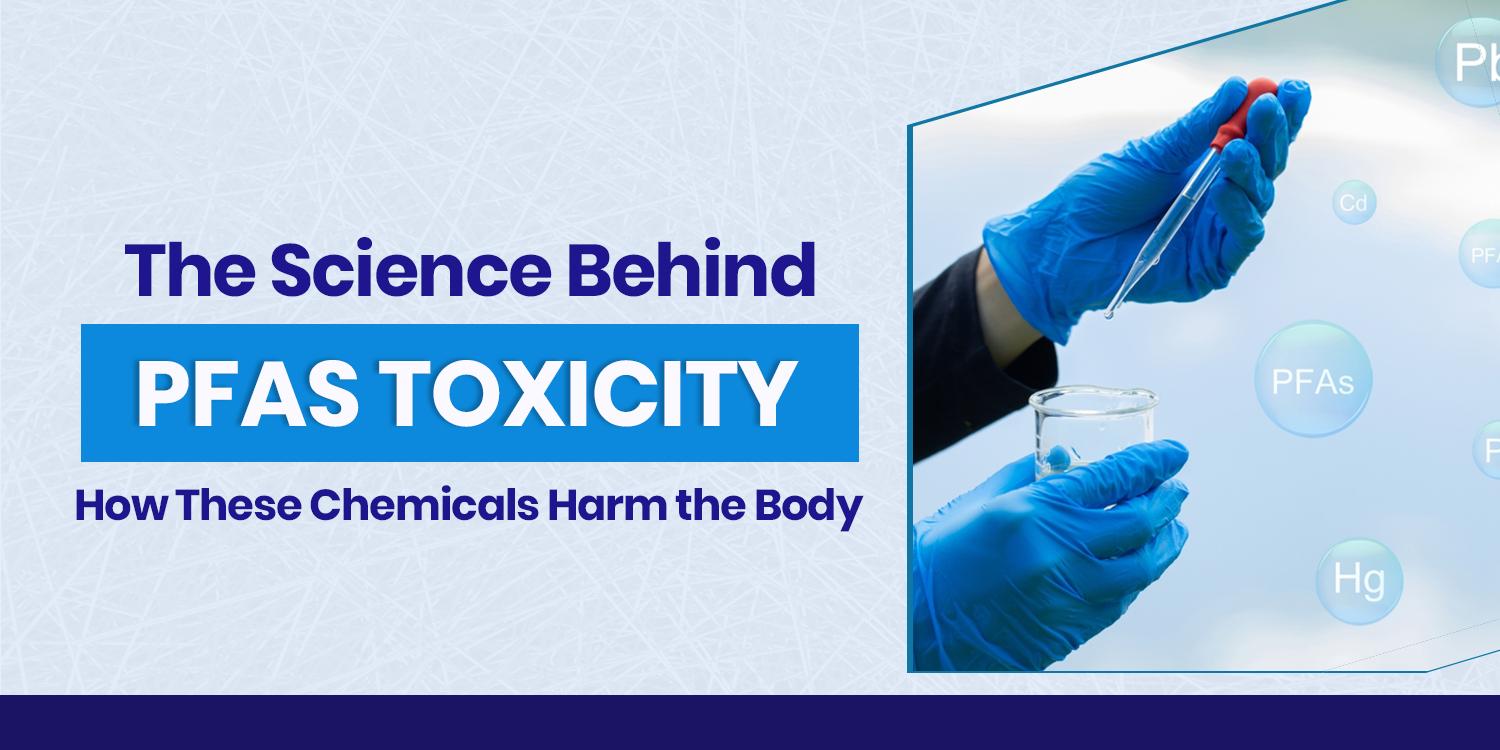For decades, PFAS (per- and polyfluoroalkyl substances) have quietly seeped into our environment from nonstick pans and waterproof jackets to firefighting foam and even the water we drink. They’re often called “forever chemicals” because they don’t easily break down. But behind this resilience lies a darker truth: PFAS toxicity poses serious risks to human health.
In this article, we’ll explore the science behind PFAS toxicity, how these chemicals interact with the body, and why understanding their effects is crucial for a safer future.
What Are PFAS and Why Are They So Persistent?
PFAS are a large family of synthetic compounds created for their remarkable resistance to heat, oil, and water. The carbon-fluorine bond that defines them is one of the strongest in organic chemistry which means these chemicals don’t degrade naturally.
This durability is why PFAS are found in so many products: nonstick cookware, food packaging, cosmetics, textiles, and industrial coatings. Unfortunately, the same property that makes them useful also makes them nearly indestructible in the environment and the human body. Over time, exposure to even trace amounts can lead to PFAS toxicity, triggering long-term health effects.
How PFAS Enter the Human Body
PFAS can enter our system in several subtle ways:
-
Contaminated water: One of the most common exposure routes, especially near industrial or military sites.
-
Food packaging: Grease-resistant wrappers and containers often leach PFAS into food.
-
Household dust: Carpets, upholstery, and treated fabrics can release PFAS particles into the air.
-
Cosmetics and personal care products: Some lotions, makeup, and sunscreens contain PFAS for water resistance.
Once absorbed, PFAS bind to proteins in the blood instead of being excreted. Unlike many toxins that the body can flush out, these chemicals linger accumulating in organs and tissues for years.
This bioaccumulation is at the heart of PFAS toxicity and its dangerous ripple effects throughout the body.
The Mechanisms of PFAS Toxicity
The molecular mechanics of PFAS toxicity are complex but fascinating. PFAS mimic fatty acids essential molecules the body uses for metabolism. Because of this, they can interfere with important signaling pathways and disrupt normal biological processes.
1. Disruption of Cellular Signaling
PFAS interact with cell receptors known as peroxisome proliferator-activated receptors (PPARs). These receptors regulate fat metabolism, inflammation, and cell growth. When PFAS activate or suppress them, it can lead to metabolic disorders, inflammation, and even tumor formation.
2. Hormonal Interference
PFAS are known endocrine disruptors. They can mimic or block hormones like estrogen, thyroid hormones, and testosterone confusing the body’s delicate hormonal balance. This is why PFAS exposure is linked to thyroid disease, infertility, and developmental issues in children.
3. Oxidative Stress and DNA Damage
Research indicates that PFAS generate reactive oxygen species (ROS) unstable molecules that damage DNA, lipids, and proteins. This oxidative stress contributes to liver injury, immune suppression, and cancer development.
4. Immune System Suppression
One of the most alarming discoveries about PFAS toxicity is its impact on the immune system. Studies have shown reduced vaccine efficacy and greater susceptibility to infections among people with high PFAS levels. In simple terms, PFAS can weaken the body’s natural defenses.
Health Impacts Linked to PFAS Exposure
The scientific evidence connecting PFAS toxicity to health problems is growing every year. Some of the most well-documented effects include:
-
Liver Damage: PFAS alter liver enzymes, leading to inflammation and fatty liver disease.
-
Reproductive Issues: Disrupted hormone function affects fertility and fetal development.
-
Immune Dysfunction: Lower antibody responses make individuals more vulnerable to infections.
-
Cancer Risk: Several PFAS types, including PFOA and PFOS, have been associated with kidney and testicular cancers.
-
Cholesterol Imbalance: PFAS exposure is linked to elevated LDL (“bad”) cholesterol levels.
Even more concerning is the cumulative nature of these effects the longer PFAS remain in the body, the greater the potential harm.
Why PFAS Toxicity Is a Global Concern
PFAS are not confined by borders. They travel through air, soil, and water, accumulating in wildlife and human populations worldwide. Studies have found PFAS in polar bears, deep-sea fish, and even newborn infants.
Because these chemicals don’t degrade, every molecule produced since the 1940s essentially still exists somewhere in the environment. This global persistence has made PFAS toxicity one of the most pressing environmental health issues of our time.
Governments and organizations worldwide are now pushing for stricter regulations and safer alternatives. The U.S. Environmental Protection Agency (EPA), for example, recently proposed enforceable limits for PFAS in drinking water a major step toward protecting public health.
Reducing Exposure: What Can Be Done?
While eliminating PFAS exposure entirely is challenging, individuals can take steps to reduce their risk:
-
Filter drinking water: Use activated carbon or reverse osmosis filters.
-
Avoid nonstick cookware: Choose ceramic, stainless steel, or cast iron instead.
-
Check product labels: Look for “PFAS-free” certifications in cosmetics, textiles, and food packaging.
-
Support cleaner manufacturing: Encourage brands that invest in safer, sustainable materials.
At Matregenix, we believe in promoting advanced material science that prioritizes both performance and environmental responsibility. As industries innovate toward greener alternatives, understanding PFAS toxicity helps guide safer material design for future generations.
The Path Forward
The story of PFAS toxicity is a sobering reminder that durability and convenience often come with hidden costs. The same chemistry that makes PFAS so useful also makes them biologically hazardous.
By bridging science, technology, and public awareness, we can mitigate the damage already done and pave the way for cleaner innovations. Continued research, transparent regulation, and responsible manufacturing are essential to breaking free from the toxic legacy of PFAS.

Join our community to interact with posts!